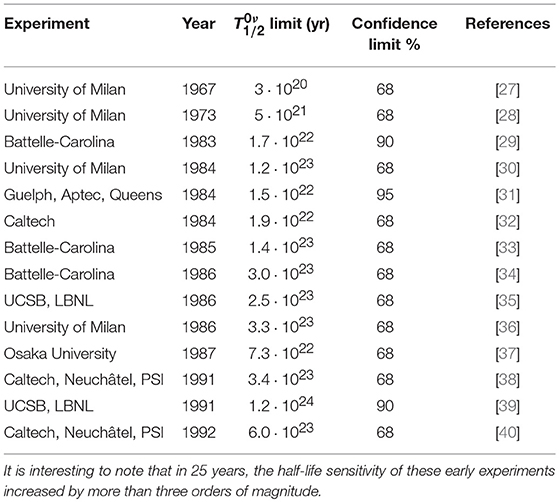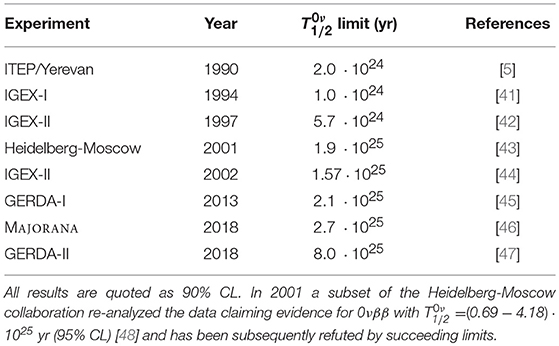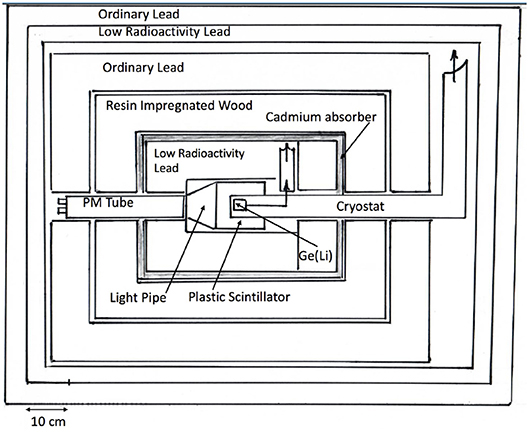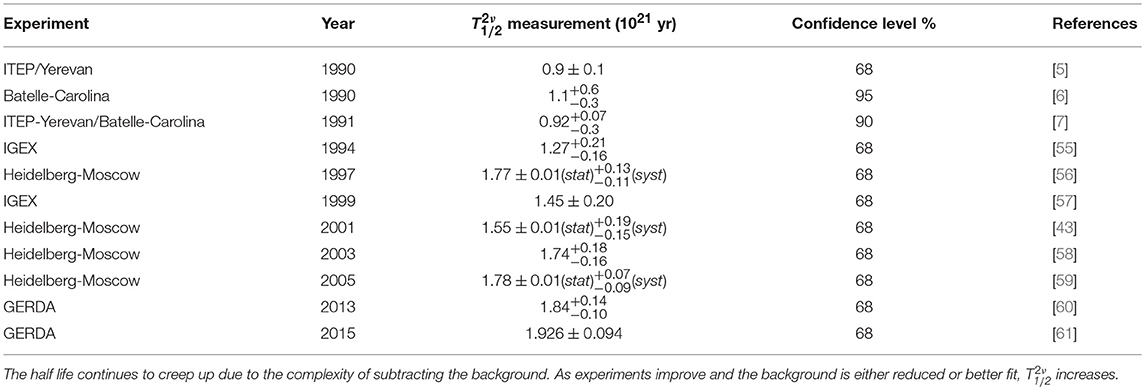- 1Department of Physics, University of South Carolina, Columbia, SC, United States
- 2Los Alamos National Laboratory, Physics Division, Los Alamos, NM, United States
High Purity Germanium Detectors have excellent energy resolution; the best among the technologies used in double beta decay. Since neutrino-less double beta decay hinges on the search for a rare peak upon a background continuum, this strength has enabled the technology to consistently provide leading results. The Ge crystals at the heart of these experiments are very pure; they have no measurable U or Th contamination. The added efforts to reduce the background associated with electronics, cryogenic cooling, and shielding have been very successful, leading to the longevity of productivity. The first experiment published in 1967 by the Milan group of Fiorini, established the benchmark half-life limit >3 × 1020 yr. This bound was improved with the early work of the USC-PNNL, UCSB, and Milan groups yielding limits above 1023 yr. The Heidelberg-Moscow and USC-PNNL collaborations pioneered the use of enriched Ge for detector fabrication. Both groups also initiated techniques of analyzing pulse waveforms to reject γ-ray background. These steps extended the limits to just over 1025 yr. In 2000, a subset of the Heidelberg-Moscow collaboration claimed the observation of double beta decay. More recently, the MAJORANA and GERDA collaborations have developed new detector technologies that optimize the pulse waveform analysis. As a result, the GERDA collaboration refuted the claim of observation with a revolutionary approach to shielding by immersing the detectors directly in radio-pure liquid argon. In 2018, the MAJORANA collaboration, using a classic vacuum cryostat and high-Z shielding, achieved a background level near that of GERDA by developing very pure materials for use nearby the detectors. Together, GERDA and MAJORANA have provided limits approaching 1026 yr. In this article, we elaborate on the historical use of Ge detectors for double beta decay addressing the strengths and weaknesses. We also summarize the status and future as many MAJORANA and GERDA collaborators have joined with scientists from other efforts to give birth to the LEGEND collaboration. LEGEND will exploit the best features of both experiments to extend the half-life limit beyond 1028 yr with a ton-scale experiment.
1. Introduction
The very earliest calculation of the rate for two-neutrino double-beta decay (2νββ) is credited to Maria Goeppert-Mayer who predicted the half-life of the decay of 130Te in 1935 [1]. In 1937, Ettore Majorana built his theory in which neutrinos are their own anti-particles [2], and in 1939, Wendell Furry proposed testing Majorana's theory by searching for neutrinoless double-beta decay (0νββ) [3]. While there were many early efforts to measure double beta decay in the laboratory, the first direct observation of 2νββ was in 82Se by Elliott et al. [4] using a Time-Projection-Chamber. The next direct measurements of 2νββ were made using Ge detectors [5–7]. However, as interesting these experiments were, the most important efforts in building low background Ge detectors were aimed at searching for 0νββ via the decay, 76Ge → 76Se + 2e−. In this article we attempt to recall the main highlights of the history of these developments.
Germanium detectors have many advantages and therefore have provided the most sensitive limits on the 0νββ half-life (), and the effective Majorana neutrino mass (〈mββ〉), for much of the recent history of neutrino physics. Recently, 136Xe experiments [8, 9] have been more restrictive, although 76Ge remains highly competitive and the technology is poised to potentially regain its previous supremacy. The search for 0νββ is fundamentally a search for a rare peak superimposed on a background continuum. Therefore, the excellent energy resolution of Ge detectors, the best of any ββ technology, provides highly sensitive discovery potential for the process. This technology also presently has the lowest background when normalized to a resolution-defined region at the 0νββ Q-value (Qββ). The detectors are made from pure metallic Ge resulting in a high atomic density and therefore a relatively large number of atoms per kg of detector. Other benefits include the detectors being mostly insensitive to surface activity and the modest cryogenic requirements of liquid nitrogen temperatures. The technology is well established and has been available as a commercial product for many decades.
As with any ββ technology, all is not ideal with Ge. Relating to 〈mββ〉 requires a nuclear matrix element (M0ν), and although 76Ge benefits from an expectedly high M0ν, also depends on a phase space factor (G0ν) as,
The modest atomic number and Qββ result in a relatively small G0ν compared to other isotopes. It has been calculated by Kotila and Iachello [10] to be 2.363·10−15 /yr and by Stoica and Mirea [11] to be 2.34·10−15 /yr (For these units of G0ν, 〈mββ〉 is taken in units of the electron mass). Since the 76Ge Qββ is low compared to the other most commonly used isotopes and given that scales as , even a small difference can be a significant effect. The enrichment cost has been decreasing but is still a concern. This cost is off-set, however, by the reduced number of detectors that must be fabricated to acquire a given 76Ge content. It should also be noted that the yearly production of Ge is large compared to the requirements for even a ton-scale experiment, so producing the required isotope will not perturb the economics of the Ge market significantly.
The long and important history Ge has played in ββ has resulted in numerous nuclear physics studies dedicated to the isotope. The calculation of M0ν is described elsewhere in this volume and not addressed here. However, one significant example is that of neutron occupancy numbers. These were measured for 76Ge [12, 13] followed by reconsideration of M0ν in light of the additional nuclear structure information. The outcome was that shell model [14] values increased a bit and the quasi-random phase approximation [15, 16] results decreased a bit bringing them closer to agreement. Other important nuclear physics measurements include a precise value for Qββ = 2039.061 ± 0.007 keV [17], and charge exchange reactions to measure transition strengths [18].
Although we leave a detailed discussion of M0ν to others, here we indicate the key references for 76Ge. The popular nuclear structure models used to calculate M0ν are: the interacting boson model (IBM-2) [19], the quasi-particle random phase approximation (QRPA) [20], the p-n pairing, QRPA [21], energy density functional methods (EDF) [22, 23], and the interacting shell model (ISM) [24, 25]. The range of values for M0ν for 76Ge varies from 2.81 to 6.13 for these calculations.
2. The Germanium Detector and Double-Beta Decay
Germanium detectors have been the mainstay of nuclear spectroscopy and related fields for more than a half a century. They replaced NaI(Tl) scintillation detectors because the energy resolution is almost 40 times better for γ rays with energies near 1 MeV. They consist of single crystals of Ge grown by the Czochralski method [26]. Germanium crystals have a diamond structure and Ge has 4 valence electrons. If a Ge crystal has impurities with only 3 valence electrons, then there will be holes throughout the lattice. This is called p-type germanium. In Ge detectors, one or more contact surfaces are heavily doped with lithium to create a surface region of n-type Ge with extra electrons. This configuration constitutes a p-n diode. To operate a Ge detector, a reverse bias voltage is applied which sweeps free holes to the negative contact and conduction-band electrons to the positive contact, essentially clearing the body of the detector of almost all electrical carriers. The crystals are cooled to about 90 K to freeze carriers from thermal excitation to the conduction band. When a γ ray, for example, interacts with an electron in the crystal, that electron cascades through the lattice creating electron-hole pairs that migrate toward the opposite sign contacts, creating a displacement current. The carriers reach the electrical contacts, and are detected with a charge-sensitive preamplifier. The number of detected charges is proportional to the energy deposited.
The early Ge detectors had Li diffused throughout the crystal to create an n-type crystal. These were called GeLi detectors and required cooling at all times to prevent the Li from migrating out of the active volume. GeLi detectors were limited in mass by the ability to drift Li uniformly throughout large crystals. Later, so called intrinsic or high-purity Ge detectors were developed in which the natural occurrence of periodic-table, group 3 impurities in the lattice constituted the content of electrical impurities. After zone-refinement and crystallization via the Czochralski technique [26], the electrical impurity level in a typical Ge detector is (2−3)·1010 electrical impurities per cm3 in the finished detector. This is hyper-pure metal when one considers that there are almost 1022 Ge atoms/cm3 in solid germanium.
The first search for ββ using a Ge detector (described below) was by Fiorini and his colleagues in the 1960s [27]. The detector was a 90-gram GeLi detector. Major improvements in technology since then have made searches for 0νββ far more sensitive. The fabrication of intrinsic Ge detectors, which can have masses of several kilograms, and the use of Ge enriched to 87% in the candidate parent isotope 76Ge, from the natural abundance of 7.8%, led to large sensitivity improvements. Finally, the development of enriched point-contact Ge detectors of about 800 g has revolutionized the ability to discriminate between backgrounds from γ rays and ββ by pulse shape discrimination. The progress in understanding the origins of background has been substantial. Although the Ge itself is very pure due to the crystal growing process, nearby cables, electronics and shielding may include trace amounts of U/Th. All of these components have seen significant purity improvement.
These developments have resulted in experimental lower bounds on of 76Ge from the earliest, 3·1020 yr to present bounds nearing 1026 yr. These recent results have inspired the formation of the LEGEND Project with the goal of reaching a sensitivity of ~ 1028. This sensitivity would probe the entire inverted neutrino-mass hierarchy for Majorana neutrinos. In this article we discuss the subject from a historical perspective, while also attempting to project into the future.
3. Early Ge Double-Beta Decay Experiments With Natural Abundance Ge
In this section we summarize the results of the early experiments culminating in the first use of enriched Ge. We provide the 0νββ results from detectors fabricated from natural-abundance Ge in Table 1 and from enriched detectors in Table 2.
3.1. The First University of Milan Experiments
The first search for 0νββ of 76Ge was performed by Fiorini and his University of Milan colleagues [27]. While many of the later results were from the analyses of data from low-background Ge counting facilities, the Milan experiment was built for the express purpose of testing lepton conservation. The heart of apparatus consisted of a 17 cm3 (~90 g) GeLi detector, with an energy resolution of ~4.7 keV at 1.32 MeV (see Figure 1). The detector was surrounded on all sides, except for the end, by a plastic scintillator veto. The entire apparatus was surrounded by a shield of 10 cm of low background lead, surrounded by a thin cadmium neutron absorbing shield, encased in a 10-cm thick box of resin impregnated wood as a neutron moderator. The outer shield was 10 cm of ordinary lead. The experiment was located in the Mount Blanc Tunnel at a location with 4,200 m of water equivalent (mwe) overburden. The background data were taken for 712 h of live time. The background rate at Qββ was 1.1·10−2 counts/(keV h), which in today's terminology is 1.06·103 counts/(keV kg yr). The data implied a bound of ≥ 3.1·1020 yr (68% CL). In addition to being the first high-resolution search for 0νββ, this was the first experiment in which the source and detector were one and the same, yielding an excellent detection efficiency.
In 1973, the Milan group published their results from a greatly upgraded experiment located in the same location in the Mount Blanc Tunnel [28]. The detector in this case was a GeLi detector with an active volume of 68.5 cm3 (~365 g). In this shield, the plastic scintillator was eliminated because it brought background. Immediately surrounding the detector cap was a Nylon-Marinelli beaker filled with doubly-distilled Hg. This was surrounded with 4 cm of electrolytic copper, encased in 10 cm of low background lead, followed by 10 cm of ordinary lead. The outer lead shield was surrounded by a 2-mm thick cadmium sheet and the entire shield was then enclosed by 20 cm of paraffin to moderate background neutrons.
There were two data collection periods totaling 4,400 h of live time. The background was 4.3·10−3 counts/(keV h). This is equivalent to ~1.02·102 counts/(keV kg yr), a factor of ten improvement in background over the 1967 result. The final result was ≥5.0·1021 yr (68% CL) [28]. The Milan Group built a new experiment with two intrinsic Ge detectors of fiducial volumes of 117 cm3 and 138 cm3, in a common shield [36]. There were several improvements in low background construction materials in the cryostat and shielding. There were two counting periods in which the shielding configuration underwent minor changes. The total counting time was 1.76 yr, and the resulting limit was ≥3.3·1023 yr (68% CL).
3.2. The Early Battelle-Carolina Experiments
The field of experimental 0νββ was dormant for a while after the 1973 Milan result. Renewed interest in 0νββ was driven by several events. First, Lubimov claimed that the electron neutrino had a mass of above 14 eV, from the data of the ITEP tritium-end-point experiment [49]. Second, interest in the theory of Grand Unification was intense and third, the shell-model calculations of the nuclear matrix elements by Haxton et al. [50], indicated significant strength for the decay of 76Ge. With these new motivations, Avignone and Greenwood proposed in 1979 an experiment, based on a Monte Carlo study with a high-purity Ge detector enclosed in a NaI(Tl) Compton suppression shield [51]. The assumed backgrounds in this proposal were taken to be similar to the Milan experiments discussed above. A trial of the experiment suggested in Avignone and Greenwood [51] was proposed to the team of Brodzinsky and Wogman at the Battelle Pacific Northwest Laboratory (now PNNL). For several years the Battelle-Carolina Collaboration worked on improving the backgrounds due to the construction materials in copper cryostats. The intrinsic Ge detector had an active volume of 125 cm3. It was operated inside a two-inch thick NaI(Tl) Compton suppression shield, inside a lead shield, covered by a boron-loaded polyethylene neutron shield, with a plastic cosmic-ray shield above the entire apparatus. The experiment was operated above ground for a live time of 4,054 h, resulting in the bound ≥1.7·1022 yr [29]. The background rate was similar to previous experiments at 1.04·102 counts/(keV kg yr). The detector was then moved to a location at 4,850 ft below the surface in the Homestake Gold Mine in Lead, South Dakota, in part of the Solar Neutrino Laboratory of Raymond Davis. That location has an overburden of ~4,300 mwe [52]. The detector was housed in a 40-cm thick, ordinary lead shield. The energy resolution was 3.7 keV at Qββ and the background rate was 47 counts/(keV kg yr). The detector was operated for 8,089 h at the same site in the Homestake mine with the result, ≥1.4·1023 yr (90% CL) [34]. The construction details are given in Brodzinski et al. [53]. The lesson learned was that much of the background, although reduced, was coming from the cryostat itself. This fact led to a significant R&D effort by the Batelle-Carolina Collaboration to create ultra-low background copper by electroforming from CuSO4 solutions onto stainless steel mandrels. The results were the production of all six of the cryostats for the International Germanium Experiment, IGEX, with electroformed copper. The IGEX experiments are discussed below.
3.3. The Guelph, Aptec, Queens Experiment
At a time shortly after the 1983 Battelle-Carolina experiment, the team of Simpson was operating a commercially built, low background Ge detector underground. The intrinsic 208 cm3 (~1.1 kg) Ge detector was operated in a salt mine near Windsor, Ontario, at a depth of about 330 m [31]. The detector was shielded with 20 cm of lead. In the final run, a 6-mm thick mercury shield was placed inside the lead castle, which absorbed the low energy bremsstrahlung from the decay of 210Bi, a daughter of the 22-yr 210Pb in the shield. Although the lead was between 150 and 200 yr old, this radiation still remained, demonstrating that the lead of the shield contained a high level of 238U. The detector operated for 2,363 h. The result was a bound of ≥3.2·1022 yr (68% CL), or ≥1.5·1022 yr at (95% CL).
3.4. The Caltech and the Neuchâtel-Caltech-PSI Experiments
The Caltech Group began their experimental series by setting up a shielded detector above ground in a sub-basement at Caltech. The overburden was only 3 mwe. The Princeton Gamma-Tech, high-purity coaxial Ge detector had a ~90 cm3 fiducial volume. The detector was surrounded with 15 cm of electrolytic copper, followed by 15 cm of lead. The shield was enclosed in an airtight box to protect the detector from airborne radon. The final result from 3,820 h of this essentially above-ground experiment was ≥1.9·1022 yr (68% CL) [32]. The next experiment involving the Caltech group was in collaboration with the University of Neuchâtel and Paul Scherrer Institute [38]. It involved 8 high-purity 140-cm3 Ge detectors, with a combined volume of 1,095 cm3 or 5.83 kg. The array was operated in the Gotthard Tunnel with an overburden of 3,000 mwe. The array of detectors was surrounded with 15 cm of oxygen-free, high-conductivity (OFHC) copper, followed by 18 cm of lead, all contained in an aluminum radon shield (see Figure 2). The array was operated for 6.2 kg yr of live time with resulting limits of ≥2.0(3.4)·1023 yr 90%(68%) CL. The final report of this collaboration [40] reported ≥6.0·1023 yr (68% CL) from 10.0 kg yr. This was the strongest bound from the natural-abundance Ge detectors.
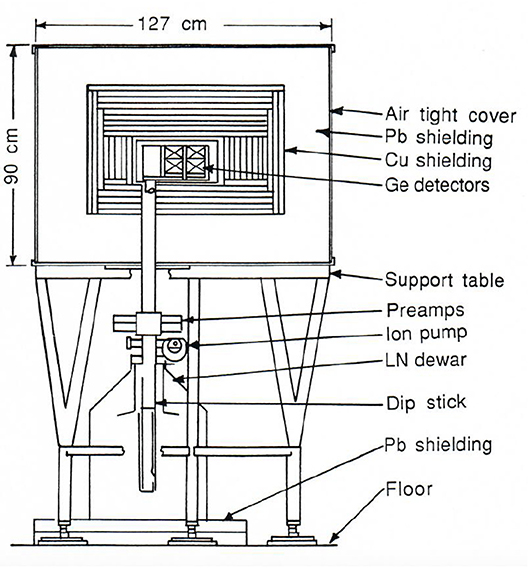
Figure 2. A diagram of the Caltech, Nuchâtel, PSI experiment with four natural abundance, high-purity Ge detectors.
3.5. The UCSB, LBNL Experiments
The UC Santa Barbara, Lawrence Berkeley National Laboratory experiment began with two intrinsic Ge detectors of 178 and 158 cm3 operating above ground in a NaI(Tl) Compton-suppression shield for 1,618 h. A later version was a configuration of four intrinsic detectors with a total fiducial volume of 658 cm3. The array had new interesting construction features, for example Si cold fingers to avoid the background due to the copper commonly used [35]. The array was operated for 3,550 h, 200 m below ground in the Power Station in the Oroville Dam in Northern California. The final result was ≥2.5·1023 yr (68% CL). The array was later used to produce very interesting data in the search for Cold Dark Matter [54].
3.6. The Osaka University Experiment
The first phase of the Osaka experiment began above ground with a 171 cm3 intrinsic Ge detector in a 4π NaI(Tl) Compton suppression shield, surrounded by a mercury shield [37]. The detector was operated for 1,600 h in the Kamioka Underground Laboratory, with an overburden of 2,700 mwe. In the second phase, the detector was operated for 7,021 h, but without the mercury shield. The final result was ≥7.3·1022 yr (68% CL).
3.7. The ITEP-Yerevan Experiment, and the Early Measurements of 2νββ of 76Ge
This experiment was the first search for 0νββ of 76Ge with detectors fabricated with Ge enriched in 76Ge [5]. This experiment consisted of three GeLi detectors, two of which were fabricated with Ge enriched to 85% in 76Ge (see Figure 3). The total mass of 76Ge was 1,008 g. The three crystals were on the end of a vertical cold finger inside of a NaI(Tl) Compton shield surrounded by several cm of copper followed by lead. The entire apparatus was inside a boron-loaded Polyethylene box 112 cm × 112 cm × 240 cm high. The experiment was operated 245 m underground, in the Avansk Mine in Yerevan, Armenia. The background at Qββ was 2.5 counts/(keV kg yr) for the two enriched crystals and 2.1 counts/(keV kg yr) for the natural crystal. A final analysis of the results yielded a limit of ≥1.0·1024 yr (90%).
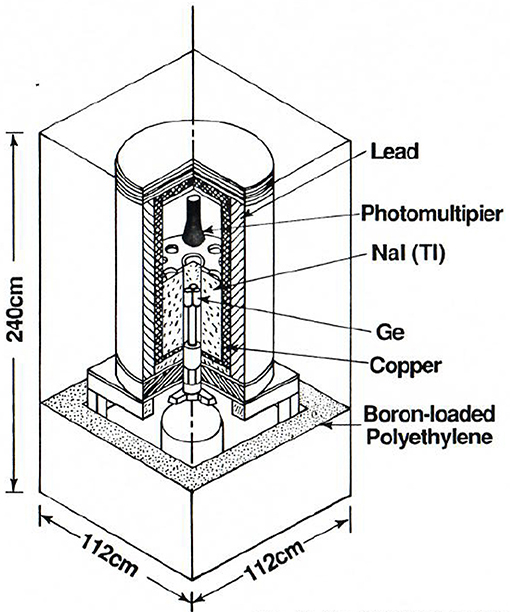
Figure 3. A diagram of the ITEP/Yerevan experiment showing the three crystals, two enriched, and one of natural abundance.
In addition, this experiment was the first direct observation of the 2νββ decay of 76Ge, and only the second such laboratory measurement following that in 82Se [4]. The result of the ITEP-Yerevan experiment was = (9±1)·1020 yr. This result was submitted to Modern Physics Letters on 23 April 1990 [5]. Later that year, the Battelle-Carolina group submitted a similar result: = yr (95% CL), to Physical Review Letters from data taken with two 1.05-kg, ultra-low background, natural abundance, intrinsic Ge detectors [6]. The two groups then merged and placed one of the ITEP-Yerevan enriched GeLi detectors in the Battelle-Carolina Cryostat to re-measure the half life. The result was = yr (2σ) [7]. It was later demonstrated that all three of these results were contaminated with internal radioactivity generated by spallation reactions of hard cosmic-ray neutrons (e.g., 60Co, 65Zn, 68Ge). These backgrounds produced events, which were partially attributed to 2νββ, resulting in deducing shorter half-lives. Results by IGEX presented at ERICE in 1993 [55], corrected for these backgrounds and found = yr (1σ). Later experiments demonstrated that these corrections for internal background, while in the correct direction, were still inadequate. Historically, the value for has increased for 76Ge indicating that the background subtraction is very difficult. Table 3 summarizes the measurements of .
3.8. The International Germanium Experiments (IGEX): The First Enriched-High-Purity Ge Detectors
In 1988, the Battelle-Carolina Collaboration concentrated on lowering background by electroforming the cryostat parts from CuSO4 solution, and acquiring Ge enriched to 86% in 76Ge. A collaboration was formed between Battelle Northwest, the University of South Carolina, the Institute of Theoretical and Experimental Physics (ITEP) Moscow, the Institute of Nuclear Research (INR) Moscow, and the University of Zaragoza. Over several installments, a total of 18 kg of Ge, enriched to 86% in 76Ge were imported to the U.S. from the two Russian institutes in oxide form. The first 5 kg from INR was reduced and zone refined by Mr. James Meyer at Eagle Picher Inc. Three 190 cm3 high-purity Ge detectors were fabricated and tested in the Homestake gold mine, at the 4,850-ft level (see Figure 4). While the energy resolution and general operation of the detectors was excellent, measurements determined that the fiducial volumes were only about 135 cm3. Difficulties in crystal growth required the Li deposition on the outer surfaces to be thicker than normal. These three detectors constituted IGEX-I. One was operated in the Homestake gold mine, one in the Canfranc Underground Laboratory, in Canfranc Spain (1,380 mwe), and one in the Baksan Neutrino Observatory, in Russia (660 mwe). The first results from IGEX-I were presented at the International Conference on Topics in Astroparticle and Underground Physics (TAUP-93), at Laboratori Nazionali del Gran Sasso (LNGS), in Assergi, Italy [41]. The data from the three detectors were combined with the result ≥1.0·1024 yr (90% CL). The average background was 0.3 counts/(keV kg yr). It was also announced at that meeting that the first of three IGEX-II detectors had been fabricated and tested. It had a fiducial volume of ~400 cm3, and an energy resolution of 2.16 keV FWHM at 1,332 keV. The first IGEX results using pulse-shape discrimination to identify background events from γ rays, was presented at Neutrino-96 at Helsinki. The result from 34.4 mole yr of data was ≥5.7·1024 yr (90% CL) [42]. While IGEX was first to build and operate high-purity Ge detectors enriched in 76Ge, by the time of this meeting, the Heidelberg Moscow Collaboration was already operating ~400 cm3 high-purity detectors and had excellent results (discussed below). The IGEX technique for pulse-shape discrimination was described in detail with IGEX-I detectors in Aalseth et al. [62], and later using the larger IGEX-II detectors in González et al. [63].
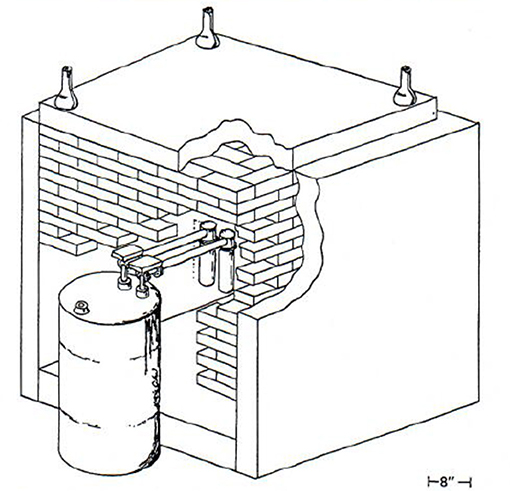
Figure 4. A diagram of the first IGEX-II detectors in the Homestake gold mine showing the detectors hanging vertically.
During the period 1996 and 1997, the IGEX collaboration had three high-purity enriched coaxial detectors produced with active volumes of ~400 cm3. The IGEX detectors had a unique configuration hanging from the end of the cold fingers. The cold finger rose from the liquid nitrogen bottle, made a 90° turn to horizontal, extended through the shield to the cold plate from which the detector cryostats were hung vertically down. This configuration prevented the radioactive contamination of Xeolite cryopump material from having a direct line of sight to the detector. The three IGEX-II detectors were tested at Homestake, then carried by ship to Barcelona Spain, and installed in the Canfranc Underground Laboratory of the University of Zaragoza. It is important to point out that by this time, the experiment of the Heidelberg-Moscow group was operating four large enriched detectors in the LNGS, and exceeded IGEX in exposure.
While there were a number of IGEX updates published in conference proceedings, the first publication of results, including the data taken with the IGEX-II detectors was in 1999, based on 78.84 mole yr of exposure. The total mass of detectors was 8.1 kg. The resulting bound was ≥0.8·1025 yr (90% CL). The data were subjected to the pulse-shape discrimination techniques described in Aalseth et al. [62] and González et al. [63]. The final IGEX result was published after a total of 117 mole yr of exposure: ≥1.57·1025 yr (90% CL) [44]. The publication of this final IGEX result set a controversy in motion. A subset of the Heidelberg-Moscow Collaboration claimed that serious errors were made in the analysis of the final IGEX results [48]. The response by the IGEX collaboration [64] clearly justified the IGEX analysis and the final result given in Aalseth et al. [44].
3.9. The Heidelberg-Moscow Experiment
The Heidelberg-Moscow Collaboration launched a very impressive experiment with five coaxial-high-purity Ge detectors enriched to 88% in 76Ge, with a total mass of 11.5 kg, and an active volume with 10.96 kg, operating in LNGS. The laboratory has an overburden of about 3,500 mwe. The detectors were enclosed in a shield with a 10-cm inner layer of ultrapure lead, surrounded by 20 cm of pure Boliden lead, enclosed in a metal box flushed with high-purity nitrogen. The shield was surrounded by 10 cm of boron-loaded polyethylene [65–67]. The experiment had an effective pulse shape analysis technique for identifying and removing background events [68]. It operated from 1990 to 2003 with a total exposure of 71.71 kg y. It was the most sensitive 76Ge experiment until the GERDA experiment commenced. There were many publications presenting the results over the years. In 2001 the collaboration published the best bound on decay: ≥1.9·1025 yr (90% CL) [69]. Later that year, a subset of the collaboration published a claim of direct observation of 0νββ of 76Ge, with a half-life of = (0.8−18.3)·1025 yr (95% CL), based on 46.5 kg yr of exposure [69, 70]. The final range of claimed values for the discovery, = (0.69−4.18)·1025 yr (95% CL), and the entire history of these experiments from 1990 to 2003, is given in Klapdor-Kleingrothaus et al. [48].
The claim of discovery was critiqued in an article coauthored by a broad list of authors [71], and later excluded by results from the GERDA Experiment (discussed below). This claim has also been excluded by the Xe experiments (KamLAND-Zen 9 and EXO 8), but the direct comparison between Ge experiments removes any caveats regarding the relative matrix element values. In addition to the search for 0νββ, the collaboration measured = yr [43] followed later by yr [72].
4. Modern Day Double-Beta Decay Experiments
The Heidelberg-Moscow experiment was based on 13 yr of very low background operation. Hence it would be a very difficult experiment to repeat. Furthermore during the 1990's and into the 2000's, ββ experiments took a back seat to the interest in solar neutrino experiments due to their role in ν oscillations. As a result there was another hiatus in 0νββ results. Interest built for ββ again in the late 2000's due to the claim of an observation and the confirmation that ν oscillations exist and, by inference, massive light neutrinos exist. In addition, the ν physics parameters indicated by the oscillation results meant that new 0νββ experiments would have discovery potential for a significant range of possible 〈mββ〉 values. The field of ββ saw a large number of new proposals advance by about 2010, including those based on 76Ge.
One key development in Ge detector technology has greatly improved their pulse shape analysis capability. That is the use of a point-contact. Originally developed for their low capacitance [73], it was after the development of modern-day transistors that the full power of this detector design began to be exploited, in particular for dark matter experiments [74]. The advantage for ββ arises because the weighting potential is strongly peaked at the contact for this geometry. This results in an electronic signal that predominately forms only when drifting charge nears the contact. Therefore, an event with multiple energy deposits within a detector will have pulse shape distinct from that of a single-site energy deposit. As ββ is a single-site energy deposit and many backgrounds are multiple site events, this is a powerful rejection capability and point-contact detectors substantially surpass the performance of the semi-coax Ge detector design that had been the field's workhorse. MAJORANA and GERDA [75] further developed and used this technology to great success.
During research and development for the MAJORANA and GERDA programs, the use of segmented detectors was considered. Segmented detectors provide enhanced waveform analysis and hence improved background rejection. A number of studies [76–79] were done considering the added advantages of segmentation on the reduction of background versus the disadvantages of the extra complexity and background due to the additional electronic channels and cables. The MAJORANA collaboration successfully developed a segmented enriched detector [80] that showed some promise. After the development of point-contact detectors, however, it became clear that the advantages of segmentation were outweighed by the disadvantages. Segmented detectors for ββ were not further pursued.
4.1. The MAJORANA Experiment
The MAJORANA DEMONSTRATOR [81, 82] experiment was established to demonstrate that backgrounds can be controlled to a level that would justify a large (ton scale) 76Ge effort. Previous 76Ge experiments with compact, high atomic-number shielding indicated that the classic design of a vacuum cryogenic-cryostat filled with Ge detectors surrounded by Pb could extend the reach of ββ physics. The MAJORANA project, named in honor of Ettore Majorana and based on this concept, began construction in 2010 with initial commissioning data collected in 2015.
The ongoing experiment is sited 4300 mwe underground at the 4800-ft level of the Sanford Underground Research Facility (SURF) [52]. The Ge detectors, 44.1 kg total with 29.7 kg enriched to 88% in 76Ge, are enclosed within two electroformed-Cu [83] cryostats. The detectors are mounted in groups of 3 to 5 and hung as strings from a cold plate cooled by a thermosyphon [84]. Very low radioactivity, front-end electronic boards [85], placed very close to the detectors, maintain signal fidelity while providing the initial amplification stage. The cryostat is contained within a 5-cm thick electrofromed Cu layer, a 5-cm thick commercial C10100 copper layer, a 45-cm thick Pb shield, two layers of plastic-scintillator cosmic-ray veto panels, 5 cm of borated poly and finally 25 cm of high density polyethylene. The material inside the veto layer is contained in an Al box that is purged with boil-off N2 to displace Rn-laden room air (see Figure 5). All materials comprising the experiment were analyzed for their radiopurity [86]. The processing of Ge for MAJORANA developed recycling techniques [87] that are critical to reduce the amount of required raw material to fabricate a given mass of detectors.
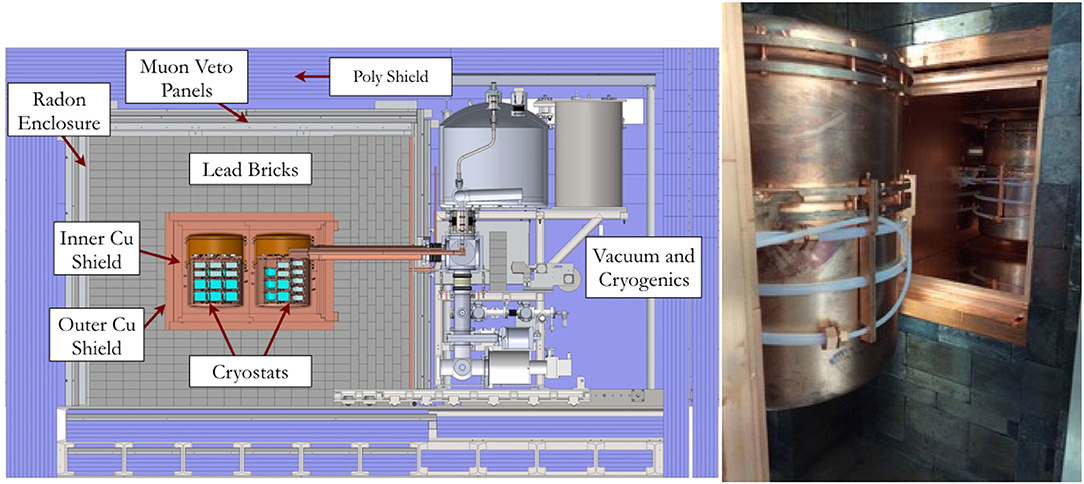
Figure 5. (Left) The shield concept for the MAJORANA DEMONSTRATOR. (Right) A photograph of one cryostat ready for insertion into the shield with the other, already installed, visible in the background. Figure and photo courtesy of the MAJORANA Collaboration.
Initial results from the DEMONSTRATOR were based on an exposure of 10 kg yr [82]. A second data release [46] based on 26 kg yr of exposure yielded a half-life limit of >2.7·1025 yr (90% CL). After removal of non-physical events, events in coincidence with the muon veto, events with multiple detectors in coincidence, and pulse shape analysis to remove single-crystal events with multiple energy deposits and surface α interactions, the final background is 11.9±2.0 counts/(FWHM t yr) or (4.7±0.8)·10−3 counts/(keV kg yr) from the 21.3 kg yr lowest background configuration. The spectra from the full 26 kg yr exposure are shown in Figure 6. The energy resolution, 2.5 keV FWHM at Qββ, is the best achieved of any ββ experiment. Although the analysis is not yet complete, early studies indicate the dominate source of background in the DEMONSTRATOR is not from nearby components within the detector arrays [88].

Figure 6. (Left) The whole spectrum from the MAJORANA DEMONSTRATOR from 26 kg-yr of exposure. (Right) The specrum near the Qββ for Ge at 2,038 keV [46]. Figures courtesy of the MAJORANA Collaboration.
The low background, excellent energy resolution and low energy threshold permit a variety of other physics measurements with MAJORANA, including tests of the Pauli Exclusion Principle, electron decay, bosonic dark matter [89, 90], and lightly ionizing particles [91]. An important low-energy background in Ge detectors is caused by spallation reactions on Ge by high-energy cosmic neutrons at the earth's surface. The important case of 68Ge production yields in enriched Ge was measured in Elliott et al. [92]. The isotope 68Ge is removed only at the enrichment stage, but both zone refining and crystal growth remove all other cosmogenic isotopes. Hence, surface exposure after each of these steps is a concern. This exposure was addressed for the MAJORANA DEMONSTRATOR detectors in several ways. First, the enriched GeO2 was shipped from Russia in a steel shipping container, developed by GERDA, that reduced the cosmogenic production of 68Ge by a factor of approximately 10. In addition, a zone-refining facility was established adjacent to the ORTEC, Inc. detector production facility and a ten-minute drive from the Cherokee Caverns, which allowed convenient underground storage of the Ge between processing steps. Finally, each part was tracked through its history with a detailed database [93]. These procedures resulted in significant reductions in the low energy background, especially tritium β-decay, and opened the door to searching for other physics. Although GERDA did not pursue a low-energy program, the collaboration followed a similar strategy to reduce cosmogenic backgrounds impacting 0νββ.
4.2. GERDA
The GERmanium Detector Array (GERDA) for 76Ge experiment arose from the idea of using liquid nitrogen (LN) as a shield because of its low radioactivity. The idea, originated by Heusser [94], was to immerse bare Ge detectors in LN, which would act as coolant and shield. This concept was developed by the GErmanium in liquid NItrogen Underground Setup (GENIUS) collaboration [95] and realized by GERDA. The GERDA collaboration [45, 47, 96, 97], however, used liquid argon (LAr) instead of LN due to its higher γ-ray stopping power. In addition, the LAr is an excellent scintillator, and was very effective as veto against background radiation external to the detector array itself.The initial GERDA goal was to confirm or refute the claim for the observation of 0νββ [98, 99].
The Ge detectors in GERDA are deployed in 7 strings, each enclosed within a nylon shroud that prevents radioactive ions (42K in particular) from electrostatic attraction to the detector surface. The group of strings is submerged in a 64 m3 volume of LAr. The cryostat containing the LAr is, itself, contained within a 590 m3 volume of pure-water. The neck of the LAr cryostat provides access for, not only the detectors, but all the associated utilities and data acquisition readout. The experiment is running at LNGS at a depth of 3,400 mwe.
The experiment has progressed through 2 phases. In Phase I, 17.6 kg of enriched Ge, including the detectors used by the HM and IGEX experiments, acquired 21.6 kg yr of data and found a half-life limit of 2.1·1025 yr (90% CL) [45]. The background index at Qββ was 0.01 counts/(keV kg yr). Phase II increased the enriched detector mass to 35.6 kg and added a light detection system to the LAr surrounding the detectors. Figure 7 shows the detector strings and LAr veto systems. This technique permitted a veto of events that deposited energy in both the Ge and Ar resulting in a significant background decrease to (5.6±3.4)·10−4 counts/(keV kg yr) in their BEGe dectectors [100]. This is the lowest background ever achieved by a 0νββ experiment when normalized to the resolution at Qββ (see Figure 8). The reported combined exposure of Phases I and II is 82.4 kg yr resulting in a half-life limit of 9.0·1025 yr (90% CL) [47], convincingly ruling out the previous claim of yr [99]. Schwingenheuer [101] strongly criticizes this claimed value and argues that one should compare to the value in Klapdor-Kleingrothaus et al. [48] of (0.69−4.18)·1025 yr with a quoted best value of 1.19·1025 yr. At this time, both are excluded by the GERDA data. GERDA has also measured = yr [60], which was followed by (1.926±0.094)·1021 yr [61]. Figures 2, 3 in that latter paper shows a measured spectrum and fits including 2νββ and the key background components. The dominance of 2νββ is clear.
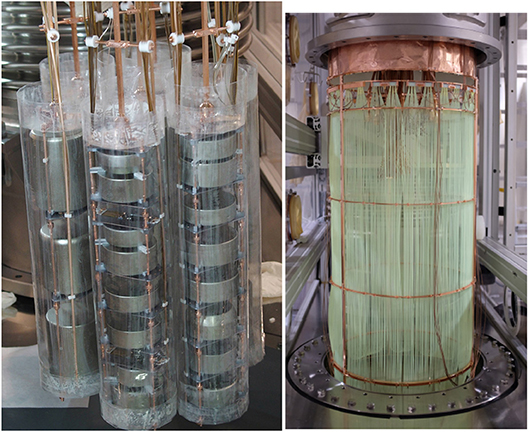
Figure 7. (Left) A photograph of the strings of detectors for GERDA. (Right) A photograph of the scintillation light collection system that surrounds the Ge detectors. Photos courtesy of the GERDA Collaboration.
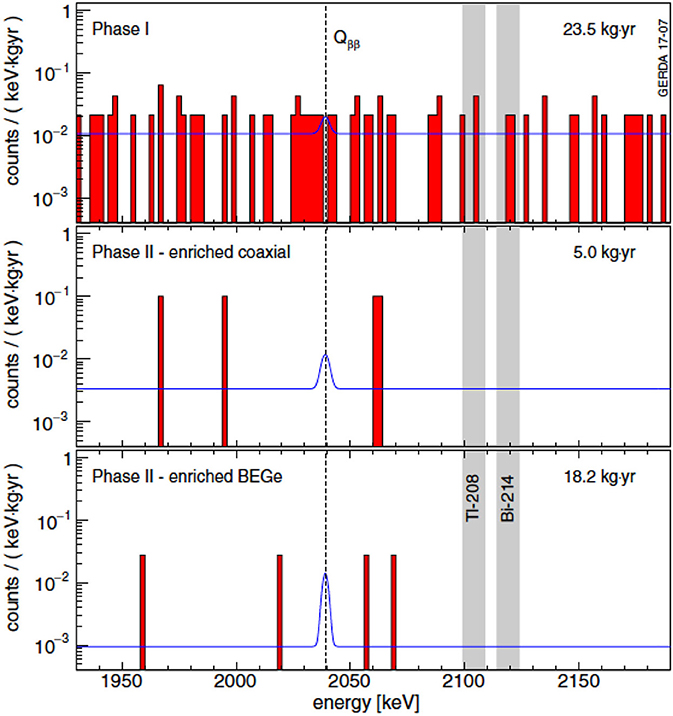
Figure 8. The spectra from the various phases of GERDA near the Qββ for Ge at 2,039 keV [47]. Figures courtesy of the GERDA Collaboration.
5. LEGEND and the Future of 0νββ Decay of 76Ge
When normalized to the resolution at Qββ, GERDA has the lowest background of any 0νββ experiment, with MAJORANA a close second. The two experiments have very modest exposures compared to other technologies but still have competitive or leading half-life limits. This situation has motivated the pursuit of a next-generation 0νββ experiment based on 76Ge. The Large Enriched Germanium Experiment for Neutrinoless Double Beta (LEGEND) Collaboration [102] aims to develop a phased, 76Ge double-beta decay experimental program with discovery potential at a half-life beyond 1028 yr, starting with existing resources as appropriate to expedite physics results. This goal has led to a phased program, LEGEND-200 and LEGEND-1000. LEGEND-200 will deploy up to 200 kg of Ge detectors within the existing GERDA infrastructure at LNGS. Only modest modifications to the lock at the top of the cryostat and the piping in the cryostat neck are required to accommodate the increased detector mass. In MAJORANA the components near the detectors, such as the front-ends and cables, were very radio-pure. In GERDA, the LAr veto was a very powerful tool for rejecting background. Using the more radio-pure parts and improving the light yield of the LAr veto system will reduce the background to 0.6 counts/(FWHM t yr) [2·10−4 counts/(keV kg yr)]. The 3σ discovery level for this configuration is estimated to be greater than 1027 yr. Figure 9 shows the discovery potential of a Ge experiment as a function of exposure for several background levels. To reach the intended goal, LEGEND-200 requires about 1 yr of exposure. The experiment is anticipated to begin operations in 2021.
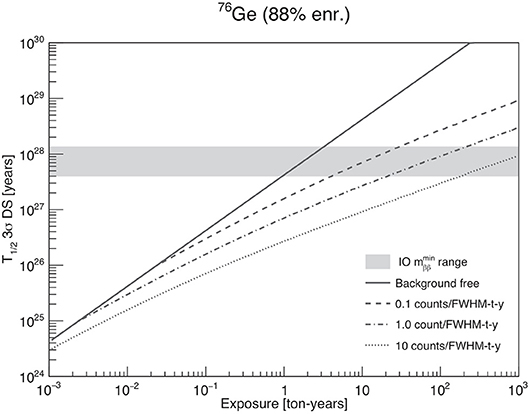
Figure 9. The 3σ discovery potential for a 76Ge experiment for several potential background levels. Figure courtesy of Jason Detwiler.
LEGEND-200 is nearly fully funded with a few requests still pending. The project is under development at the time of this writing. LEGEND-1000 is envisioned to deploy a ton of isotope within 5 payloads into LAr (see Figure 10). The goal is to reach a limit of >1028 yr.
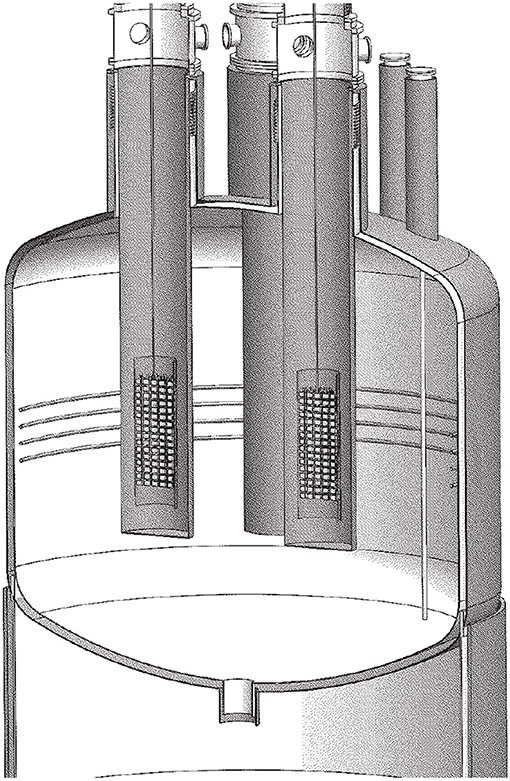
Figure 10. The concept for LEGEND-1000 showing a number of the deployments Ge detectors. This cut-away view shows three of five 200-kg groupings of Ge. Figure courtesy the LEGEND Collaboration.
6. Conclusion
Germanium detectors have excellent energy resolution and very low background. As a result, limits on from Ge are very competitive even when the exposure is much less than competing technologies. Detectors fabricated from Ge have historically provided outstanding constraints on and 〈mββ〉. From the first Ge-based experimental result in 1967, limits on have improved by a factor of 2·105 over the intervening 50 year period. The technology continues to advance and an additional improvement in sensitivity of more than a factor of 100 is within reach in the near future.
Author Contributions
All authors listed have made a substantial, direct and intellectual contribution to the work, and approved it for publication.
Funding
FA thanks the National Science Foundation for support under grant NSF1614611. SE thanks the Department of Energy Office of Nuclear Physics for support under contract number DE-AC52-06NA25396. SE acknowledges the support of the U.S. Department of Energy through the LANL/LDRD Program.
Conflict of Interest Statement
The authors declare that the research was conducted in the absence of any commercial or financial relationships that could be construed as a potential conflict of interest.
Acknowledgments
We would like to acknowledge the collaborations that provided input for this manuscript including MAJORANA, GERDA, and LEGEND. We specifically thank Bernhard Schwingenheuer, Riccardo Brugnera, and Vince Guiseppe for careful readings.
References
1. Goeppert-Mayer M. Double beta-disintegration. Phys Rev. (1935) 48:512–6. doi: 10.1103/PhysRev.48.512
2. Majorana E. A symmetric theory of electrons and positrons. Nuovo Cimento (1937) 5:171–84. English Translation: Soryushiron Kenkyu (1981) 63:149.
3. Furry WH. On transition probabilities in double beta-disintegration. Phys Rev. (1939) 56:1184–93. doi: 10.1103/PhysRev.56.1184
4. Elliott SR, Hahn AA, Moe MK. Direct evidence for two-neutrino double-beta decay in 82Se. Phys Rev Lett. (1987) 59:2020–3. doi: 10.1103/PhysRevLett.59.2020
5. Vasenko AA, Kirpichnikov IV, Kuznetsov VA, Starostin AS, Dzhanian AG, Markosian GE, et al. New results in the ITEP/YePI double beta-decay experiment with enriched germanium detectors. Mod Phys Lett A (1990) 5:1299–306. doi: 10.1142/S0217732390001475
6. Miley HS, Avignone FTIII, Brodzinski RL, Collar JI, Reeves JH. Suggestive evidence for the two-neutrino double-β decay of 76Ge. Phys Rev Lett. (1990) 65:3092–5. doi: 10.1103/PhysRevLett.65.3092
7. Avignone FTIII, Brodzinski R, Guerard C, Kirpichnikov I, Miley H, et al. Confirmation of the observation of 2νββ decay of 76Ge. Phys Lett B (1991) 256:559–61. doi: 10.1016/0370-2693(91)91810-I
8. Albert JB, Anton G, Badhrees I, Barbeau PS, Bayerlein R, Beck D, et al. Search for neutrinoless double-beta decay with the upgraded EXO-200 detector. Phys Rev Lett. (2017) 120:072701. doi: 10.1103/PhysRevLett.120.072701
9. Gando A, Gando Y, Hachiya T, Hayashi A, Hayashida S, Ikeda H, et al. Search for majorana neutrinos near the inverted mass hierarchy region with KamLAND-Zen. Phys Rev Lett. (2016) 117:082503. doi: 10.1103/PhysRevLett.117.082503
10. Kotila J, Iachello F. Phase-space factors for double-β decay. Phys Rev C (2012) 85:034316. doi: 10.1103/PhysRevC.85.034316
11. Stoica S, Mirea M. New calculations for phase space factors involved in double-β decay. Phys Rev C (2013) 88:037303. doi: 10.1103/PhysRevC.88.037303
12. Schiffer JP, Freeman SJ, Clark JA, Deibel C, Fitzpatrick CR, Gros S, et al. Nuclear structure relevant to neutrinoless double β decay: 76Ge and 76Se. Phys Rev Lett. (2008) 100:112501. doi: 10.1103/PhysRevLett.100.112501
13. Kay BP, Schiffer JP, Freeman SJ, Adachi T, Clark JA, Deibel CM, et al. Nuclear structure relevant to neutrinoless double β decay: the valence protons in 76Ge and 76Se. Phys Rev C (2009) 79:021301(R). doi: 10.1103/PhysRevC.79.021301
14. Menéndez J, Poves A, Caurier E, Nowacki F. Occupancies of individual orbits, and the nuclear matrix element of the 76Ge neutrinoless ββ decay. Phys Rev C (2009) 80:048501. doi: 10.1103/PhysRevC.80.048501
15. Suhonen J, Civitarese O. Effects of orbital occupancies on the neutrinoless ββ matrix element of 76Ge. Phys Lett B (2008) 668:277. doi: 10.1016/j.physletb.2008.08.056
16. Šimkovic F, Faessler A, Vogel P. 0νββ nuclear matrix elements and the occupancy of individual orbits. Phys Rev C (2009) 79:015502. doi: 10.1103/PhysRevC.79.015502
17. Mount BJ, Redshaw M, Myers EG. Double-β-decay Q values of 74Se and 76Ge. Phys Rev C (2010) 81:032501(R). doi: 10.1103/PhysRevC.81.032501
18. Thies JH, Frekers D, Adachi M, Dozono H, Ejiri H, Fujita Y, et al. The (3He,t) reaction on 76Ge, and the double-β-decay matrix element. Phys Rev C (2012) 86:014304. doi: 10.1103/PhysRevC.86.014304
19. Barea J, Kotila J, Iachello F. 0νββ and 2νββ nuclear matrix elements in the interacting boson model with isospin restoration. Phys Rev C (2015) 91:034304. doi: 10.1103/PhysRevC.91.034304
20. Šimkovic F, Rodin V, Faessler A, Vogel P. 0νββ and 2νββ nuclear matrix elements, quasiparticle random-phase approximation, and isospin symmetry restoration. Phys Rev C (2013) 87:045501. doi: 10.1103/PhysRevC.87.045501
21. Hyvärinen J, Suhonen J. Nuclear matrix elements for 0νββ decays with light or heavy majorana-neutrino exchange. Phys Rev C (2015) 91:024613. doi: 10.1103/PhysRevC.91.024613
22. Vaquero NL, rodríguez TR, Egido JL. Shape and pairing fluctuation effects on neutrinoless double beta decay nuclear matrix elements. Phys Rev Lett. (2013) 111:142501. doi: 10.1103/PhysRevLett.111.142501
23. Yao JM, Song LS, Hagino K, Ring P, Meng J. Systematic study of nuclear matrix elements in neutrinoless double-β decay with a beyond-mean-field covariant density functional theory. Phys Rev C (2015) 91:024316. doi: 10.1103/PhysRevC.91.024316
24. Menéndez J, Poves A, Caurier E, Nowacki F. Disassembling the nuclear matrix elements of the neutrinoless ββ decay. Nucl Phys A (2009) 818:139. doi: 10.1016/j.nuclphysa.2008.12.005
25. Horoi M, Neacsu A. Shell model predictions for 124Sn double-β decay. Phys Rev C (2016) 93:024308. doi: 10.1103/PhysRevC.93.024308
26. Kakimoto K. Development of crystal growth technique of silicon by the czochralski method. ACTA Polonica A (2013) 124:227. doi: 10.12693/APhysPolA.124.227
27. Fiorini E, Pullia A, Bertolini G, Cappellani F, Restelli G. A search for lepton non-conservation in double beta decay with a germanium detector. Phys Lett B (1967) 25:602–3. doi: 10.1016/0370-2693(67)90127-X
28. Fiorini E, Pullia A, Bertolini G, Cappellani F, Restelli G. Neutrinoless double-beta decay of 76Ge. Nuovo Cim A (1973) 13:747–63. doi: 10.1007/BF02784100
29. Avignone FTIII, Brodzinski RL, Brown DP, Evans JC, Hensley WK, Reeves JH, et al. New limits on the neutrino mass, lepton conservation, and no-neutrino double beta decay of 76Ge: new limit on the majorana mass of νe. Phys Rev Lett. (1983) 50:721–4. doi: 10.1103/PhysRevLett.50.721
30. Bellotti E, Cremonesi O, Fiorini E, Liguori C, Pullia A, Sverzellati P, et al. New limits on double beta decay of 76Ge. Phys Lett B (1986) 146:450–6. doi: 10.1016/0370-2693(84)90158-8
31. Simpson JJ, Jagam P, Campbell JL, Malm HL, Robertson BC. New limit for neutrinoless double β decay of 76Ge. Phys Rev Lett. (1984) 53:141–3. doi: 10.1103/PhysRevLett.53.141
32. Forster A, Kwon H, Markey JK, Boehm F, Henriksons HE. Low background study of the neutrinoless double beta decay of 76Ge and upper limit for neutrino mass. Phys Lett. (1984) 138:301–3. doi: 10.1016/0370-2693(84)91665-4
33. Avignone FTIII, Brodzinski RL, Brown DP, Evans JC, Hensley WK, Miley HS, et al. Ultralow-background study of neutrino less double β decay of 76Ge. Phys Rev Lett. (1985) 54:2309–12. doi: 10.1103/PhysRevLett.54.2309
34. Avignone FTIII, Brodzinski RL, Evans JC, Hensley WK, Miley HS, Reeves JH. Search for the double-β decay of 76Ge. Phys Rev C. (1986) 34:666–77. doi: 10.1103/PhysRevC.34.666
35. Caldwell DO, Eisberg RM, Grumm DM, Hale DL, Witherell MS, Goulding FS, et al. Half-life limits on the zero-neutrino and two-neutrino double-β decay of 76Ge. Phys Rev D (1986) 33:2737–9. doi: 10.1103/PhysRevD.33.2737
36. Bellotti E, Cremonesi O, Fiorini E, Liguori C, Pullia A, Sverzellati PP, et al. The Milano experiment on lepton number nonconservation in double beta-decay of 76Ge. Nuovo Cim A (1986) 95:1–46. doi: 10.1007/BF02768738
37. Ejiri H, Kamikubota N, Nagai Y, Nakamura T, Okada K, Shibata T, et al. Double beta decay of 76Ge to 0+ and 2+ states on 76Se studied by the β−γ coincidence method. J Phys G (1987) 13:839–46. doi: 10.1088/0305-4616/13/6/012
38. Treichel M, Boehm F, Broggini C, Reusser D, Fisher P, Fluri L, et al. Double beta decay and dark matter in the Gotthard germanium experiment. J Phys G (1991) 17:S193–201. doi: 10.1088/0954-3899/17/S/020
39. Caldwell DO. Double beta decay - present and future. J Phys G (1991) 17:S137–44. doi: 10.1088/0954-3899/17/S/014
40. Reusser D, Treichel M, Boehm F, Fisher P, Gabathuler K, Henrikson HE, et al. Final report on the search for neutrinoless double-β decay of 76Ge from the Gotthard underground experiment. Phys Rev D (1992) 45:2548–51. doi: 10.1103/PhysRevD.45.2548
41. Avignone FTIII, Brodzinski RL, Collar JI, Courant H, Garcia E, Guerard CK, et al. The International Germanium Experiment (IGEX) in 1993. Nucl Phys B (1994) 35(Suppl.):354–7. doi: 10.1016/0920-5632(94)90275-5
42. Aalseth CE, Avignone FTIII, Brodzinski RL, Collar JI, Gonzales D, Garcia E, et al. IGEX with pulse shape discrimination in 1996. In: Neutrino '96. Proceedings, 17th International Conference on Neutrino Physics and Astrophysics. Helsinki (1996). p. 361–8.
43. HV Klapdor-Kleingrothaus, A Dietz, L Baudis, G Heusser, IV Krivosheina, B Majorovits, et al. Latest results from the Heidelberg-Moscow double beta decay experiment. Eur Phys J A (2001) 12:147–54. doi: 10.1007/s100500170022
44. Aalseth CE, Avignone FTIII, Brodzinski RL, Cebrian S, Garcia E, Gonzalez D, et al. IGEX 76Ge neutrinoless double-beta decay experiment: prospects for next generation experiments. Phys Rev D (2002) 65:0920071. doi: 10.1103/PhysRevD.65.092007
45. Agostini M, Allardt M, Andreotti E, Bakalyarov AM, Balata M, Barabanov I, et al. Results on neutrinoless double beta decay of 76Ge from GERDA Phase I. Phys Rev Lett. (2013) 111:122503. doi: 10.1103/PhysRevLett.111.122503
46. Guiseppe V. New results from the MAJORANA DEMONSTRATOR experiment. In: Neutrino 2018, International Conference on Neutrino Physics and Astrophysics. Heidelberg (2018).
47. Agostini M, Bakalyarov AM, Balata M, Barabanov I, Baudis L, Bauer C, et al. Improved limit on neutrinoless double-β decay of 76Ge from GERDA Phase II. Phys Rev Lett. (2018) 120:132503. doi: 10.1103/PhysRevLett.120.132503
48. Klapdor-Kleingrothaus HV, Deitz A, Krivosheina IV. Critical view to: IGEX 76Ge neutrinoless double-beta decay experiment: prospects for next generation experiments. Phys Rev D (2004) 70:078301. doi: 10.1103/PhysRevD.70.078301
49. Lubimov V, Novikov E, Nozik V, Tretyakov E, Kosik V. An estimate of the νe mass from the β-spectrum of tritium in the valine molecule. Phys Rev B (1980) 94:266–8.
50. Haxton WC, Stevenson Jr GJ, Strottman D. Double beta decay and the majorana mass of the electron neutrino. Phys Rev Lett. (1981) 47:153–6. doi: 10.1103/PhysRevLett.47.153
51. Avignone FTIII, Greenwood ZD. A monte-carlo evaluation of an improved-sensitivity, 76Ge double-beta-decay experiment. Nucl Instrum Meth (1979) 160:493–7. doi: 10.1016/0029-554X(79)90205-2
52. Heise J. The Sanford Underground Research Facility at Homestake. J Phys Conf Ser. (2015) 606:012015. doi: 1.1088/1742-6596/606/1/012015
53. Brodzinski RL, Miley HS, Reeves JH, Avignone FTIII. Further reduction of radioactive backgrounds in ultrasensitive germanium spectrometers. Nucl Instrum Meth A (1990) 292:337–42. doi: 10.1016/0168-9002(90)90389-N
54. Caldwell DO, Eisberg RM, Grumm DM, Witherell MS, Sadoulet B, Goulding FS, et al. Laboratory limits on galatic cold dark matter. Phys Rev Lett. (1988) 61:510–3. doi: 10.1103/PhysRevLett.61.510
55. Avignone FTIII. Double-beta decay: some recent results and developments. Prog Part Nucl Phys. (1994) 32:223–45. doi: 10.1016/0146-6410(94)90022-1
56. Günther M, Hellmig J, Heusser G, Hirsch M, Klapdor-Kleingrothaus HV, Maier B, et al. Heidelberg-Moscow ββ experiment with 76Ge: full setup with five detectors. Phys Rev D (1997) 55:54–67. doi: 10.1103/PhysRevD.55.54
57. Morales A. Review on double beta decay experiments and comparison with theory. Nucl Phys B (1999) 77:335–45. doi: 10.1016/S0920-5632(99)00440-5
58. Dörr C, Klapdor-Kleingrothaus HV. New Monte-Carlo simulation of the Heidelberg-Moscow double beta decay experiment. Nucl Instrum Meth A (2003) 513:596–621. doi: 10.1016/j.nima.2003.07.018
59. Bakalyarov AM, Baylsh AY, Belyaev ST, Lebedev VI, Shukov SV. Results of the experiment on investigation of germanium-76 double beta decay. Phys Part Nucl Lett. (2005) 2:77–81.
60. Agostini M, Allardt M, Andreotti E, Bakalyarov AM, Balata M, Barabanov I, et al. Measurement of the half-life of the two-neutrino double beta decay of Ge-76 with the GERDA experiment. J Phys G (2013) 40:035110. doi: 10.1088/0954-3899/40/3/035110
61. Agostini M, Allardt M, Bakalyarov AM, Balata M, Barabanov I, Barros N, et al. Results on ββ decay with emission of two neutrinos or majorons in 76Ge from GERDA Phase I. Eur Phys J. C (2015) 75:416. doi: 10.1140/epjc/s10052-015-3627-y
62. Aalseth CE, Avignone FTIII, Brodzinski RL, Miley HS, Reeves JH. Using pulse shape discrimination to sort individual energy deposition events in a germanium crystal. J Radioanal Nucl Chem. (1998) 233:119–25. doi: 10.1007/BF02389658
63. González D, Morales J, Cebrián S, García E, Irastorza I, Morales A, et al. Pulse shape discrimination in the IGEX experiment. Nucl Instrum Meth A (2003) 515:634–43. doi: 10.1016/j.nima.2003.06.008
64. Aalseth CE, Avignone FTIII, Brodzinski RL, Cebrian S, Garcia E, Gonzales D, et al. The IGEX experiment reexamined: a response to the critique of Klapdor-Kleingrothaus, Dietz, and Krivosheina. Phys Rev D (2004) 70:078302. doi: 10.1103/PhysRevD.70.078302
65. Balysh A, Beck M, Belyaev S, Bockholt J, Demehin A, Gurov A, et al. Sub-ev limit for the neutrino mass from 76Ge double beta decay by the Heidelberg-Moscow experiment. Phys Lett. (1995) 356:450–5. doi: 10.1016/0370-2693(95)00817-5
66. Baudis L, Günther M, Hellmig J, Heusser G, Hirsch M, Klapdor-Kleingrothaus H, et al. The Heidelberg-Moscow experiment: improved sensitivity for 76Ge neutrinoless double beta decay. Phys Lett B (1997) 407:219–24. doi: 10.1016/S0370-2693(97)00756-9
67. Klapdor-Kleingrothaus HV. Double beta decay - Physics beyond the standard model. In: Proceedings of the 17th International Conference on Neutrino Physics and Astrophysics Neutrino '96. Helsinki (1996). p. 317–41.
68. Hellmig J, Klapdor-Kleingrothaus H. Identification of single-site events in germanium detectors by digital pulse shape analysis. Nucl Instrum Meth A (2000) 455:638–44. doi: 10.1016/S0168-9002(00)00563-5
69. Klapdor-Kleingrothaus HV, Dietz A, Harvey HL, Krivosheina IV. Evidence for neutrinoless double beta decay. Mod Phys Lett A (2001) 16:2409–20. doi: 10.1142/S0217732301005825
70. Klapdor-Kleingrothaus HV, Deitz A, Krivosheina IV. Neutrinoless double beta decay: status of evidence. Found Phys. (2002) 32:1181–223. doi: 10.1023/A:1019722802931
71. Aalseth CE, Avignone FTIII, Barabash A, Boehm F, Brodzinski RL, Collar JI, et al. Comment on ‘Evidence for neutrinoless double beta decay'. Mod Phys Lett A (2002) 17:1475–8. doi: 10.1142/S0217732302007715
72. Klapdor-Kleingrothaus H, Dietz A, Krivosheina I, Chkvorets O. Data acquisition and analysis of the 76Ge double-beta experiment in Gran Sasso 1990-2003. Nucl Instrum Meth A (2004) 522:371–406. doi: 10.1016/j.nima.2003.12.013
73. Luke PN, Goulding FS, Madden NW, Pehl RH. Low capacitance large volume shaped-field germanium detector. IEEE Trans Nucl Sci. (1989) 36:926–30. doi: 10.1109/23.34577
74. Barbeau PS, Collar JI, Tench O. Large-mass ultra-low noise germanium detectors: performance and applications in neutrino and astroparticle physics. JCAP (2007) 9:9. doi: 10.1088/1475-7516/2007/09/009
75. Budjáš D, Heider MB, Chkvorets O, Khanbekov N, Schönert S. Pulse shape discrimination studies with a broad-energy germanium detector for signal identification and background suppression in the GERDA double beta decay experiment. JINST (2009) 4:P10007. doi: 10.1088/1748-0221/4/10/P10007
76. Elliott SR, Gehman VM, Kazkaz K, Mei DM, Young AR. Pulse shape analysis in segmented detectors as a technique for background reduction in Ge double-beta decay experiments. Nucl Instrum Meth A (2006) 588:504–10. doi: 10.1016/j.nima.2005.12.024
77. Abt I, Altmann M, Caldwell A, Kröninger K, Liu X, Majorovits B, et al. Background reduction in neutrinoless double beta decay experiments using segmented detectors - a Monte Carlo study for the GERDA setup. Nucl Instrum Meth A (2007) 570:479–86. doi: 10.1016/j.nima.2006.10.188
78. Abt I, Caldwell A, Kröninger K, Liu J, Liu X, Majorovits B. Identification of photons in double beta-decay experiments using segmented germanium detectors - studies with a GERDA Phase II prototype detector. Nucl Instrum Meth A (2007) 583:332–40. doi: 10.1016/j.nima.2007.09.017
79. Abt I, Caldwell A, Gutknecht D, Kröninger K, Lampert M, Liu X, et al. Characterization of the first true coaxial 18-fold segmented n-type prototype detector for the GERDA project. Nucl Instrum Meth A (2007) 577:574–84. doi: 10.1016/j.nima.2007.03.035
80. Leviner L, Aalseth C, Ahmed M, Avignone F, Back H, Barabash A, et al. A segmented, enriched n-type germanium detector for neutrinoless double beta-decay experiments. Nucl Instrum Meth A (2014) 735:66–77. doi: 10.1016/j.nima.2013.08.081
81. Abgrall N, Aguayo E, Avignone FTIII, Barabash AS, Bertrand F, Boswell M, et al. The MAJORANA DEMONSTRATOR neutrinoless double-beta decay experiment. Adv High Energy Phys. (2014) 2014:365432. doi: 10.1155/2014/365432
82. Aalseth CE, Abgrall N, Aguayo E, Alvis SI, Amman M, Arnquist I, et al. Search for neutrinoless double-β decay in 76Ge with the MAJORANA DEMONSTRATOR. Phys Rev Lett. (2018) 120:132502. doi: 10.1103/PhysRevLett.120.132502
83. Hoppe E, Aalseth C, Farmer O, Hossbach T, Liezers M, Miley H, et al. Reduction of radioactive backgrounds in electroformed copper for ultra-sensitive radiation detectors. Nucl Instrum Meth A (2014) 764:116–21. doi: 10.1016/j.nima.2014.06.082
84. Aguayo E, Busch M, Daniels R, Fast JE, Green MP, Reid DJ. Design of an ultra-low background thermosyphon for the MAJORANA DEMONSTRATOR. Nucl Instrum Meth A (2013) 709:17–21. doi: 10.1016/j.nima.2012.11.191
85. Barton P, Luke P, Amman M, Chan Y, Detwiler J, Loach J, et al. Low-noise low-mass front end electronics for low-background physics experiments using germanium detectors. In: Proceedings of 2011 IEEE Nucl Sci Symp Conf Rec.. Valencia (2011). p. 1976–9.
86. Abgrall N, Arnquist I, Avignone FTIII, Back H, Barabash A, Bertrand F, et al. The MAJORANA DEMONSTRATOR radioassay program. Nucl Instrum Meth A (2016) 828:22–36. doi: 10.1016/j.nima.2016.04.070
87. Abgrall N, Arnquist I, Avignone FTIII, Barabash A, Bertrand F, Bradley A, et al. The processing of enriched germanium for the MAJORANA DEMONSTRATOR and R&D for a possible future ton-scale Ge-76 double-beta decay experiment. Nucl Instrum Meth A (2018) 877:314–22. doi: 10.1016/j.nima.2017.09.036
88. Caldwell T, et al. Searching for neutrinoless double-beta decay in Ge-76 with the MAJORANA DEMONSTRATOR. In: International Workshop on Double Beta Decay and Underground Science, DBD18. Hawaii. p. 21–3. (2018).
89. Abgrall N, Aguayo E, Avignone FTIII, Barabash AS, Bertrand F, Bradley A, et al. Search for pauli exclusion principle violating atomic transitions and electron decay with a p-type point contact germanium detector. Eur Phys J C (2016) 76:619. doi: 10.1140/epjc/s10052-016-4467-0
90. Abgrall N, Aguayo E, Avignone FTIII, Barabash AS, Bertrand F, Bradley A, et al. New limits on bosonic dark matter, solar axions, pauli exclusion principle violation, and electron decay from the MAJORANA DEMONSTRATOR. Phys Rev Lett. (2017) 118:161801. doi: 10.1103/PhysRevLett.118.161801
91. Alvis S, Arnquist I, Avignone FTIII, Barabash A, Barton CJ, Bertrand F, et al. First limit on the direct detection of lightly ionizing particles for electric charge as low as e/1000 with the MAJORANA DEMONSTRATOR. Phys Rev Lett. (2018) 120:211804. doi: 10.1103/PhysRevLett.120.211804
92. Elliott S, Guiseppe V, LaRoque B, Johnson R, Mashnik S. Fast-neutron activation of long-lived isotopes in enriched Ge. Phys Rev C (2010) 82:054610. doi: 10.1103/PhysRevC.82.054610
93. Abgrall N, Aguayo E, Avignone FTIII, Barabash AS, Bertrand F, Brudanin V, et al. The MAJORANA parts tracking database. Nucl Instrum Meth. A (2015) 779:52–62. doi: 10.1016/j.nima.2015.01.001
94. Heusser G. Low radioactivity background techniques. Ann Rev Nucl Part Sci. (1995) 45:543–90. doi: 10.1146/annurev.ns.45.120195.002551
95. Klapdor-Kleingrothaus H, Chkvorets O, Krivosheina I, Strecker H, Tomei C. First ten kg of naked germanium detectors in liquid nitrogen installed in the GENIUS-test-facility. Nucl Instrum Meth A (2003) 511:341–6. doi: 10.1016/S0168-9002(03)01928-4
96. Ackermann K-H, Agostini M, Allardt M, Altmann M, Andreotti E, Bakalyarov AM, et al. The GERDA experiment for the search of 0νββ decay in 76Ge. Eur Phys J C (2013) 73:2330. doi: 10.1140/epjc/s10052-013-2330-0
97. Agostini M, Allardt M, Bakalyarov A, Balata M, Barabanov I, Baudis L, et al. Background free search for neutrinoless double beta decay with Gerda Phase II. Nature (2017) 544:47–52. doi: 10.1038/nature21717
98. Klapdor-Kleingrothaus H, Krivosheina I, Dietz A, Chkvorets O. Search for neutrinoless double beta decay with enriched 76Ge in Gran Sasso 1990-2003. Phys Lett B (2004c) 586:198–212. doi: 10.1016/j.physletb.2004.02.025
99. Klapdor-Kleingrothaus HV, Krivosheina IV. The evidence for the observation of 0νββ decay: the identification of 0νββ events from the full spectra. Mod Phys Lett A (2006) 21:1547–66. doi: 10.1142/S0217732306020937
100. Zsigmond AJ. New results from GERDA Phase II. In: Neutrino 2018, International Conference on Neutrino Physics and Astrophysics. Heidelberg (2018).
101. Schwingenheuer B. Status and prospects of searches for neutrinoless double beta decay. Ann Phys. (2013) 525:269–80. doi: 10.1002/andp.201200222
Keywords: double beta decay, neutrino, Ge detectors, Majorana, Dirac
Citation: Avignone FT III and Elliott SR (2019) The Search for Double Beta Decay With Germanium Detectors: Past, Present, and Future. Front. Phys. 7:6. doi: 10.3389/fphy.2019.00006
Received: 01 November 2018; Accepted: 11 January 2019;
Published: 05 February 2019.
Edited by:
Sabin Stoica, Horia Hulubei National Institute for R&D in Physics and Nuclear Engineering (IFIN-HH), RomaniaReviewed by:
Carlo Giunti, Istituto Nazionale di Fisica Nucleare (INFN), ItalyChao Zhang, Brookhaven National Laboratory (DOE), United States
Copyright © 2019 Avignone and Elliott. This is an open-access article distributed under the terms of the Creative Commons Attribution License (CC BY). The use, distribution or reproduction in other forums is permitted, provided the original author(s) and the copyright owner(s) are credited and that the original publication in this journal is cited, in accordance with accepted academic practice. No use, distribution or reproduction is permitted which does not comply with these terms.
*Correspondence: Steven R. Elliott, ZWxsaW90dHNAbGFubC5nb3Y=
 Frank T. Avignone III1
Frank T. Avignone III1 Steven R. Elliott
Steven R. Elliott